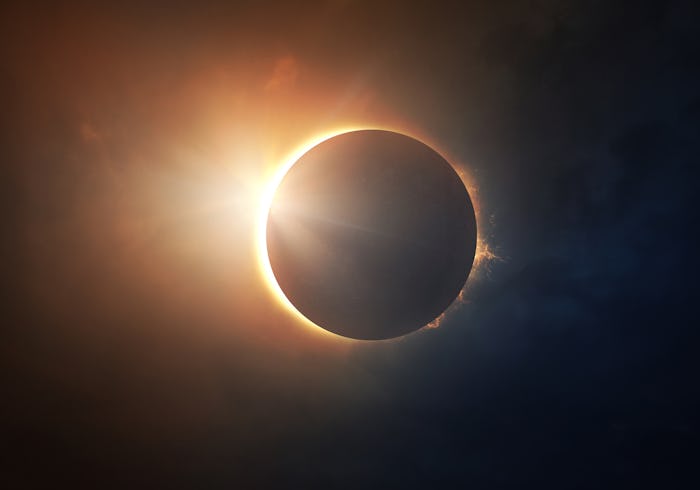Life

What Experts Want You To Know About Your Kids Watching The Solar Eclipse
On Aug. 21, 2017, a once-in-a-lifetime solar eclipse will amaze young and old across America, and yes, you definitely want your children to witness this Grand Canyon of astronomical events. But can kids watch the solar eclipse safely? Romper spoke to the American Academy of Ophthalmology (AAO) for advice, and their warning may surprise you. If you have images of toilet paper tubes stuffed with red plastic film floating in your head, it's time to put those DIY ideas to rest, and take solar retinopathy — or blindness caused by sun rays — seriously.
Scientists call it the Great American Eclipse. The umbra-shadowed sun will sweep from Oregon to South Carolina in 94 breath-taking minutes, offering millions of Americans a chance to witness a partial or total solar eclipse — which the States haven't seen since 1979. But don't allow your eagerness to experience it first-hand compromise your vision — or your child's.
Russell N. Van Gelder, MD, PhD, Professor of Ophthalmology at University of Washington School of Medicine and clinical spokesperson for the AAO, wants parents to know that staring at the sun is extremely dangerous:
"The sun’s rays pack an enormous amount of energy, and the optics of the eye focus all of that energy onto a very small point. So it’s really like taking a magnifying lens outside on a sunny day and burning leaves with it. You can literally burn a hole in the retina ... So it’s essential that parents help their kids with safe viewing of the eclipse."
Van Gelder's prescription? Disposable cardboard glasses approved by the International Standards Organization. As a label, Prada won't cut it. Eclipse glass lenses are actually a thousand times darker than your standard Ray-Bans, and the only way to be certain your eclipse glasses offer adequate protection is to check that they read ISO12312-2. These glasses are super affordable — we're talking a dollar or two — and you can easily buy them online or at retail stores. Accept no substitutions.
"It’s essential to have the correct lenses and the correct polymer," notes Van Gelder, and the AAO has good reason to get the word out. The organization that promotes the ISO12312-2 eclipse glasses only endorsed them in 2015. The magic ingredient in the lens is "a derivative of Mylar," according to Van Gelder, and it's the only proven safe way to view the eclipse.
Because more than 200 million people live within driving range of the path of totality, according to CBS, Van Gelder guesses that more than a few are likely to suffer eye damage on Aug. 21.
And it only takes a few seconds to cause irreparable damage to the human eye. "If you take a magnifying lens on a sunny day and pulled it over a dark piece of paper, the paper would start to smoke within seconds," warns Van Gelder. He adds that there are no pain fibers in the retina, so despite human aversion to looking directly at the sun, people can force themselves to do it. Unfortunately, the result of looking too long is a blind spot in the center of the retina. Van Gelder has a 71-year-old patient who tried to watch the eclipse through smoked glass — decades later, he remains blind in one eye.
So buy the glasses, and watch your kids (even if that means less eclipse for you) to make sure they don't take them off. Van Gelder further warns that even wearing these glasses, it's unsafe for kids to view the eclipse through binoculars or a telescope, which focus potentially harmful light, and require filters of their own. The AAO urges parents to get the word out.
The solar eclipse is exciting, and Van Gelder himself fondly remembers witnessing an eclipse when he was 7 years old. There's no need to deprive your kids of a lifelong memory — just be sure to pack the proper equipment. As for my family, we'll be driving to Wyoming this Aug. 21, ISO-approved eclipse glasses in tow.